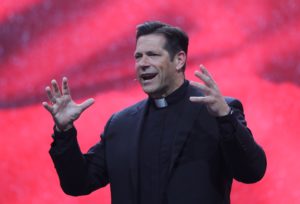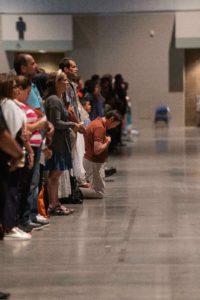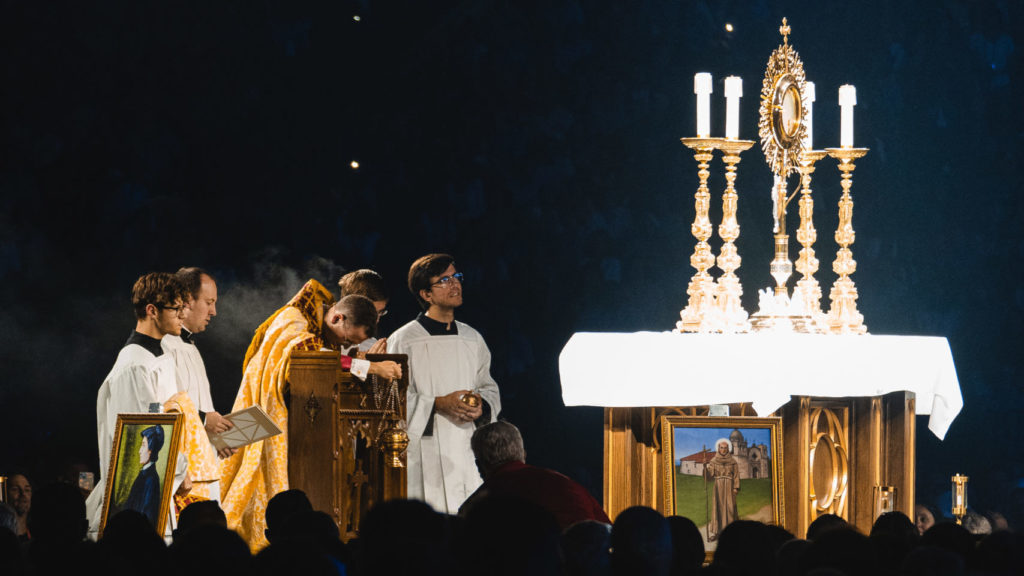For five days in mid-July, the streets of downtown Indianapolis were painted with the different colors of American Catholicism.
There were Guadalupanos, Latin Mass-going “trads,” aspiring Catholic influencers, Baby Boomer retirees, cassock-wearing seminarians, youth group kids, charismatics, pro-life activists, and perhaps most strikingly, an army of baby strollers being pushed by couples with young children.
“It’s nothing compared to anything that I’ve ever seen before,” said Arianna Rodriguez, 20, who came with a small group from St. Isaac Jogues Church in Orlando, Florida.
Participants young and old, from near and from far, made similar observations. It was hard to say when, or even if, such a diverse mix of Catholics had ever gathered on U.S. soil for such an event.
What brought them here?
Set in a centrally located city known as “the crossroads of America,” the National Eucharistic Congress (NEC) was the climax of a three year “revival” organized by the U.S. bishops as a response to declining belief and devotion in the Eucharist, the sacrament described by the Second Vatican Council as “the source and summit of Christian life.”

The liturgies, processions, and mini-congresses held in parishes and dioceses as part of the revival were all supposed to lead up to this: a two-month national pilgrimage with four separate routes converging on Indianapolis, where the NEC offered a variety of formational, educational, and liturgical experiences with something in mind for everyone — all 60,000 of them.
But the biggest draw of the NEC, many participants told Angelus, was not only the excitement of being around so many people of faith, but that it responded to a tangible sense of growing indifference to faith in today’s world — and even in the Church, too.
“I just think a lot of us are lukewarm,” said Emma Taylor of Denver, Colorado. “We don’t know why we’re still Catholic.”
Speaking to Angelus after attending a July 19 panel on the challenges of Catholic dating sponsored by the Catholic University of America, Taylor said she’d had her “first true encounter” with the Eucharist at the age of 16 while praying in front of the Blessed Sacrament.
“I think our Church needs to be renewed, and we need to all come to terms with our wounds and do the healing that we need to do in order to follow the Catholic faith,” said Taylor. “I think that that’s what’s preventing a lot of people from truly living it out. We’re not willing to forgive, and that’s a crucial part of experiencing God’s love.”
Taylor was one of several Congress-goers who reported being inspired by the words of star speaker and podcaster Father Mike Schmitz on the NEC’s second night, who told the thousands inside Lucas Oil Stadium that “you can never have a revival without repentance.”
“If the remedy for ignorance is to get to knowledge, and the road to knowledge is truth, the remedy for indifference is love, and the road to love is repentance,” said Schmitz, a chaplain at the University of Minnesota-Duluth.
For all the concern about belief in the Real Presence of Jesus Christ in the Eucharist, Schmitz said, the deeper issue is that “we know — we just don’t care.”
Many of those interviewed by Angelus in Indianapolis suggested that Schmitz’s talk set the tone for the Congress.
“We’re not perfect. We’re sinners, just trying to be saints,” said Denise Gomez of Inglewood. “At Mass, we bring our sins to the front of the cross. And we just ask God’s forgiveness, and we can feel that in his presence.”
Like others who spoke to Angelus, Gomez cited the decision to close churches and limiting access to the Eucharist due to the spread of COVID-19 in the early months of the pandemic as a source of frustration — and motivation to make the most of opportunities like the Congress.
“That was when my faith increased the most, because I didn’t have any other distractions,” said Gomez. “So I really focused on going to daily Mass.”
“Our hunger for the Eucharist grew,” added Elsie Garcia, who teaches catechism to children with Gomez at St. John Chrysostom Church in Inglewood.

If visitors to Indianapolis were looking for ideas on how to bring the “Revival” back home, they might have benefited from conversations with people like Moises Espinal and Virgil Chad Burge, two Knights of Columbus from Holy Family Church in Pass Christian, Mississippi, located in the Diocese of Biloxi.
Alarmed by the drop in Mass attendance after the COVID shutdowns, their parish decided to take a more “intentional” approach to inviting parishioners back.
“We found that what has worked, or paid a lot of dividends, is actually meeting and doing things outside [the parish],” said Espinal. “Trying to break the mold from more traditional settings to places where people can go and still be vulnerable while discussing the Word.”
To reach out to men their age, parishioners like Espinal and Burge have organized hangouts at local cigar bars where men can smoke, “drink a few beers, and talk about the Word of God.”
Burge, who came from Protestantism before converting at age 32, said he’s seen success in calling parishioners on the phone, rather than sending emails or text messages, to invite them to parish activities.
Today, Espinal and Burge said, Mass attendance at their parish is higher than it was pre-COVID.
“It’s the personal connection,” said Burge. “If you personally invite someone to do something, it’s hard to say no.”
The opportunities for in-person networking and conversations with people from around the country, Espinal said, is one reason why he believes the Congress will “yield amazing results for the diocese and for the Church here in the U.S.”
Perhaps more immediate “results” could be found in the stories of pilgrims like Kjell Yu, who also came with the Orlando group. With the start of college just a few weeks away on his mind, Yu wasn’t “really deep into my faith” and didn’t want to come to Indianapolis. But by the end of the Congress’ closing Mass on Sunday, July 21, something had changed.
“Now that I’ve experienced this whole journey, it’s really just changed my whole perspective, especially adoration — hands down,” said Yu.
The 18-year-old said he got the sign he was looking for during a moment of evening adoration inside Lucas Oil Stadium. Kneeling in silence, his prayers turned to a young man he saw nearby who appeared visibly uninterested.
“I was like God, please help him at least see your love,” said Yu. Moments later, the man seemed to spring to life and began singing during the next song.
“Even something so small, just gave me a bit more, a bit more reassurance he’s actually there, giving us love.”

By and large, the NEC has been hailed by organizers, attendees, and observers as an overwhelming success.
Fears of lower-than-expected attendance dissipated as organizers saw a surge in registrations in the final weeks before the Congress, then another wave of participants with one-day passes who decided to extend their stay. Some observers compared the “energy” inside Lucas Oil Stadium on the streets of Indianapolis during the July 20 Eucharistic procession to the time St. Pope John Paul II visited Denver for World Youth Day in 1993.
“The energy of this room could change our country,” said Bishop Robert Barron of the Diocese of Winona-Rochester, Minnesota, in a rousing half-hour catechesis during the Congress’ final (and largest) evening session on July 20.
The words of Jesus in the Last Supper, “this is my body, given up for you,” Barron said, point to an important truth about the Eucharist: “Your Christianity is not for you.”
“Christianity is not a self-help program, something designed just to make us feel better about ourselves,” said Barron. “Your Christianity is for the world.”
By the end of his talk, focused on what the three evangelical counsels (poverty, chastity, and obedience) mean for lay people, Barron invited the crowd to “bring the light of Christ into the secular world.”
“The great revival will have been a failure if we don’t change our society, if we don’t stream out of this place with the light of Christ.”
In the same vein, organizers framed the Congress as the start of a new missionary phase for Catholicism in the U.S., to be followed by similar pilgrimages and congresses.
In his homily at a July 20 Spanish Mass, Archbishop José H. Gomez said the revival should lead the Church in the U.S. to “a new Eucharistic evangelization.” Later that day, in a talk given on Our Lady of Guadalupe as “the Marian heart of America,” the archbishop compared the challenge of evangelizing under daunting circumstances to the mission entrusted to St. Juan Diego by the Virgin in 16th-century Mexico.
“When Juan Diego heard her call, he protested,” he said. In the same way, Catholics may sometimes feel that “we’re too small, not powerful enough, not worthy enough, to do the work of evangelizing.”
“But God does not call us to be perfect, he calls us to be faithful,” added Archbishop Gomez.
Just hours after it had ended on Sunday, more than one participant took to social media to excitedly claim that what they’d just witnessed promised fruits for the U.S. church on the scale of the 1993 World Youth Day in Denver, largely credited with inspiring a wave of new apostolates, ministries, and religious vocations in the country.
Such results would take years — even a few generations — to bear out. But at the very least, the Congress undoubtedly left pilgrims with a sense of hope for themselves — and for the Church — that had been missing.
“I’m excited,” said the 18-year-old Yu as he left the Congress’ closing Mass on Sunday. “This experience is definitely going to change my life for the better.”

